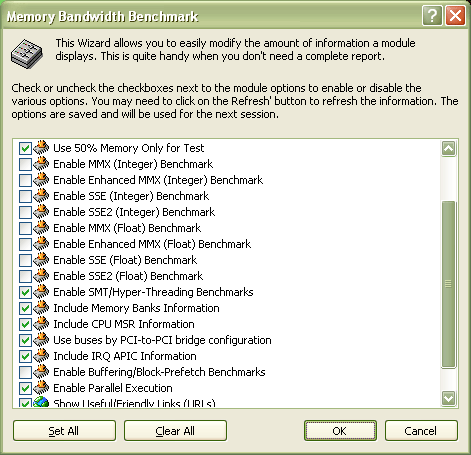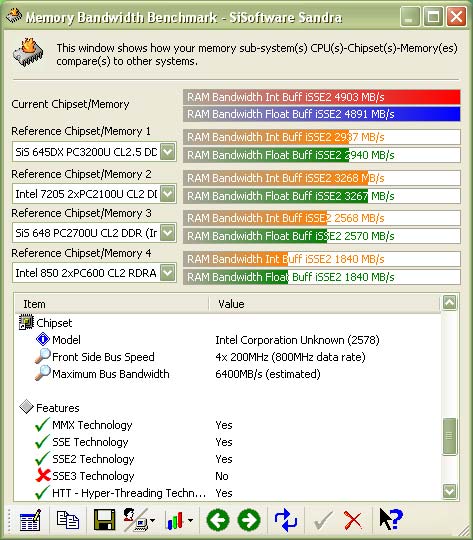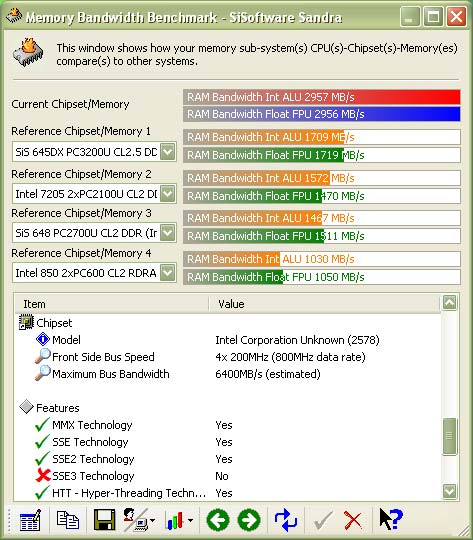Searching for the Memory Holy Grail: Part 1
by Wesley Fink on July 27, 2003 11:13 PM EST- Posted in
- Memory
Test Design
AnandTech has had reservations about the usefulness of synthetic benchmarks to measure the performance of computers. However, testing memory is one area where it is hard to avoid synthetic benchmarks. We were particularly concerned about some of the memory benchmarks we have seen posted with the 875/865 chipset boards. Some of the more widely-used synthetic benchmarks are being used to “demonstrate” performance that we logically know – based on Intel 865/865 chipsets white papers – to be not the case.
MemTest86
MemTest86 has been around for many years, and it is the standard in Memory Testing for many computer enthusiasts. The program boots from CD-ROM or floppy using its own DOS-like operating system, and tests memory at its most basic level. To many enthusiasts, this program is the ultimate test to determine the stability of memory. If you wonder why we would use such an ancient benchmark, it is because we have not found anything that is really better to test memory performance and stability. Apparently, we are not alone, since MemTest86 is still widely used in the Memory industry to test the stability of memory modules.
As a baseline, MemTest86 was run on an 875 Canterwood system with a Pentium 4 3.0GHz CPU and 2x512MB double-sided high-speed DIMMs at timings of 2,5,2,2. This gives us a MemTest86 score at Default Settings of 2,722MB/sec.
More information on MemTest86 is available at their site. Floppy and ISO versions of the program are also available at this site for download.
UNBuffered Memory Performance in Windows XP
In search of a reliable memory benchmark, we find that SiSoft Sandra 2003 is one of the more widely used memory benchmarks. Looking closer, we did not feel the standard Sandra memory test, which relies heavily on synthetic memory buffering techniques, provided the kind of sensitivity we needed for these tests. It is true that Sandra uses the same buffering techniques as in the CPU and chipset tests, but these buffering techniques themselves can often mask poor memory performance and sometimes provide memory performance scores that do not correlate well with real-world performance.
While we don’t know exactly where it started, we have seen a number of enthusiast sites using a variation of the Sandra Memory, which turns off buffering techniques and comes closer to measuring raw memory performance. Macci was one of the first to use the UNBuffered benchmark – the famous Finn who is always at or near the top of the 3DMark scores. In addition, Tony Leach in England and I have used it in many reviews on other web sites.
The idea of the UNBuffered Memory Benchmark is very simple – you merely turn off all memory buffering techniques. Sandra makes this very easy to do. Select ‘Memory Benchmark’, right-click ‘Module Options’, and uncheck the 9 boxes that have to do with buffering.

The UNBuffered Memory Benchmarks are quite different from what you may be accustomed to seeing. As an example, these are Buffered or Standard Memory benchmarks with two double-sided DIMMs on a 875 Canterwood board at stock 3.0GHz at DDR400 at memory timings of 2-5-2-2.

Using the same settings for the UNBuffered Memory Benchmark (3.0GHz, DDR400, 2-5-2-2, 2x512MB DIMMs), we achieved much lower numbers.

Please look carefully at the screen captures above, and notice that THE MEMORY BAR STATES “BUFF” IN THE DESRIPTION ON A STANDARD TEST. “BUFF” IS NOT USED IN THE DESCRIPTION IN THE UNBUFFERED MEMORY TEST
While the score of the UNBuffered benchmark is much lower than the standard Memory Test, the UNBuffered benchmarks are very comparable to MemTest86 results. This excellent correlation of MemTest86 and SiSoft Sandra UNBuffered Memory Test results seems to be true in most situations. Benchmarks are only useful in the end in how they can compare different configurations and hardware. We have found standard Dual-Channel DDR400 Performance on Intel 875/865 chipset motherboards, as you see above, in the 2300 to 3000 MB/sec range as measured with the Sandra UNBuffered Memory Benchmark. MemTest86 gives similar results.
We will post a few more sets of Buffered (Standard) and UNBuffered Sandra 2003 benchmarks in this review to demonstrate the validity of the UNBuffered benchmark as a Memory Performance testing tool, and then use only UNBuffered benchmarks for the rest of the review.










42 Comments
View All Comments
Anonymous User - Tuesday, July 29, 2003 - link
Wesley Fink - Monday, July 28, 2003 - link
Yes, you read it correctly. the mixed dimms can vary from very large drops - 20 to 27% or so - to very little if any drop for closely matched pairs. Performance seems to fare best when mixed pairs are the same capacities and the same "bank" configuration.ViRGE - Monday, July 28, 2003 - link
Very good article, Wesley, but I'm a bit confused on your mixed vs. matched DIMM comparison. On the 1st configuration, 2x256DS + 2x512DS, the timings look to be the same as in the 1st table on page 4, the DDR 400 numbers. Am I reading this correctly? It seems odd(although believable) that memory bandwidth dropped 25%, even though it stayed as 4 DS DIMMs at the same timings.PrometheusN - Monday, July 28, 2003 - link
Thanks to a reader for pointing out one correction to this article. The Intel White Paper from the 865 chart reverses 1 and 2 memory positions compared to the 875 white paper. While I did not test 865 performance in the review, I did make reference to the White Paper Chart.We can also wonder, with Intel not sanctioning PAT on the 865, exactly how the 865 boards WITH PAT will behave, and if memory on an 865 with PAT changes back to the same as 875.
Anonymous User - Monday, July 28, 2003 - link
You did not close your table on page eight.3 4 DS/td> Dual Channel
Add a < to the "/td>" ;)
Otherwise... Great article, very informing, thanks for taking the time to write this up.
PrometheusN - Monday, July 28, 2003 - link
Single-Sided or Double-Sided IS a functional description - but it normally is also a visual description. BEWARE dimms that skip every other chips on both sides. These have 4 chips on each side, but are functionally Single-Sided.PrometheusN - Monday, July 28, 2003 - link
According to CPU-Z 1.18C, 4 Sticks of ram - single or double - do NOT disable "PAT" on the DFI 875PRO or the Asus P4C800-E. It depends on how the motherboard BIOS handles the 4 Dimms.Wesley Fink
Shalmanese - Monday, July 28, 2003 - link
Nice article but what are the real world consequences of these numbers? When DDR was 1st introduced, we only saw a ~10% peroformance increase from a 100% increase in memory bandwidth so I am thinking that the difference between 2 and 4 banks would be trivial.ghg - Monday, July 28, 2003 - link
Hi PromNice review, as we expected from you 8-).
Using 4 sticks of doublesided OCZ 3700 Gold disables PAT according to CPU-Z 1.18c.
Same behavior when taking 4 sticks of singlesided OCZ 4000 ?
Ciao
Gary
ghg - Monday, July 28, 2003 - link